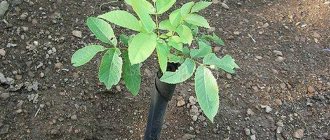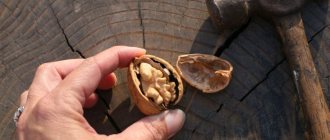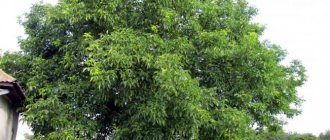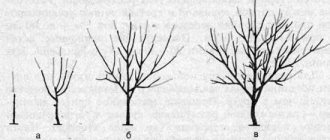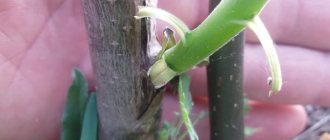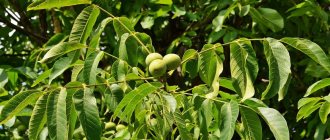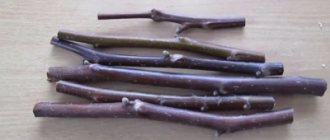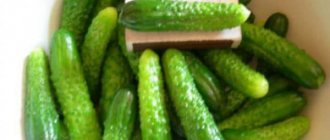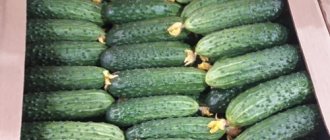Diseases and pests
The following diseases can affect a walnut tree:
- White spot: affects leaves. A waxy coating appears in the form of spots on the bottom of the plates. At first they are colored pale green, and then become white. Over time, the affected leaves die. To combat the disease, the crop is sprayed with copper preparations.
- Marsoniosis or brown spot: affects leaves and young shoots. Accompanied by the formation of brown spots, which over time increase in size and merge. Sick plants tolerate winter worse and may even die. The disease is of fungal origin, so fungicides are used to combat it.
- Bacterial burn: a very dangerous disease, the first symptoms of which appear in early spring. First, the ovaries turn black and fall off, followed by leaves and young shoots. There is no effective treatment for the disease, so the affected tree will have to be dug up and burned.
The most effective preventative against diseases is spraying with pesticides. It is carried out in several stages:
- in the leaf opening phase;
- before flowering and immediately after it;
- and also at the very beginning of fruit formation.
If organic gardening is practiced, it is enough to regularly remove weeds, loosen the soil around the tree trunk and apply fertilizers in the dosages recommended by the manufacturer.
The main pest of the crop is the nut moth. This is a gray butterfly that lays eggs, from which voracious larvae hatch. They gnaw holes in the fruits and make them unfit for consumption.
Attention!
To prevent the spread of larvae, special trapping belts are attached to the tree trunk. If the pest still appears, the tree is sprayed with Actellik at a dosage of 12 ml of product per 10 liters of water.
Section on the topic Common diseases and pests of walnuts.
Korenovsky nut is one of the best crops to grow in the garden. The tree is compact, but at the same time it produces a bountiful harvest and does not require special care. In addition, the unusual arrangement of fruits in clusters will make the nut a real decoration of the garden.
Large-fruited
Large fruit determines the weight of the fruit, which breeders are constantly trying to increase by breeding new species. Each of them has its own advantages and disadvantages. However, all gardeners note their high yield and kernel quality.
The most popular are listed in the table:
| Name | Core weight, g | Productivity, kg/s 1 unit. |
| Harvest | 9–11 | 30 |
| Bukovina bomb | 18 | 37 |
| Kalasharsky | 15–19 | 35 |
| Giant | 35 | 100 |
| Ideal | 10 | 120 |
| Memory Minov | 15 | 27 |
Today, breeders have developed dozens of variations of walnut varieties for successful planting of gardens in the middle zone and the Krasnodar region. All species are endowed with increased winter hardiness, high taste and commercial qualities of the kernel. Fruiting occurs from the end of September to October.
Did you know? In 1999, breeders at the University of California, Davis, first developed walnuts with red kernels. The variety is patented under the name Robert Livermore. Later, this hybrid was bred in Moldova and Russia.
To select seedlings and successfully grow them, you should also take into account the climate and soil composition. The correct selection of crop varieties will provide the gardener with high yields for many years.
Criteria for selecting varieties
Each gardener selects a variety of nuts to suit his needs, growing conditions and climate characteristics in the region. There are many criteria that a particular type of tree selected for a particular site must meet.
Winter-hardy varieties
This criterion is decisive when selecting a nut for cultivation in the middle zone. These climatic conditions are considered harsh for southern plants, so not every hybrid is able to take root there even if a good shelter is provided for it. Only a few varieties can meet the increased requirements of the variable climate of the middle zone.
Lateral views
In another way, these varieties of nuts are characterized as having a lateral type of fruiting. The lateral view is ideal for breeders. The advantage of such plants is that fruits can form not only on the tops of ripened shoots, but also on young branches. This ability significantly increases the productivity of plants with lateral type of ovary formation.
Precocious
Any gardener who plants a new seedling on his plot dreams of quickly enjoying the fruits of his labor. In this case, preference is given to early-fruiting varieties. Such nuts bear their first fruits already 4 years after they are planted in the garden. Productivity, taste and characteristics of the fruit are at a high level.
short
Trees of small height not only allow you to plant a larger number of plants in a small area, but also greatly facilitate the harvesting process. With compact dimensions, they produce a good harvest of high-quality fruits.
For different regions of Russia
In addition to all other characteristics, there are varieties of nuts zoned for a specific region. As a rule, these are the fruits of the labor of local breeders. They contain certain genetic indicators that will make them a priority in a given area. This may be increased cold resistance, drought resistance, resistance to certain diseases.
Late varieties
Such varieties can be grown exclusively in regions with a warm climate (for example, Krasnodar Territory). Otherwise, the crop will not ripen. The advantage of late nuts is good disease resistance, large fruit, keeping quality of the harvest, and excellent taste of the fruit. As a rule, they are not precocious.
Other criteria
In addition to the listed criteria for choosing nut varieties for the garden, there are many more parameters. It can be:
- fruit size;
- method of formation of ovaries;
- shell thickness;
- spreading crown.
Care after landing
2 weeks after planting, the nut seedling needs to be watered well. The water consumption rate is 15-20 liters. If the region does not belong to zones of sufficient moisture, careful monitoring of the condition of the tree trunk circle will be required in the future. Watering should be regular, but not excessive.
Walnut seedling Ideal needs crown formation. If planting was done in the spring, you can do the first pruning immediately. If it’s in the fall, you can postpone it until spring. In an ordinary garden, the nut is formed into a “bowl”. To do this, select 3-4 good skeletal branches and cut the central conductor above the top one.
Scheme of formation of the cup-shaped crown of the Ideal nut
In the future, pruning will need to be done annually. The main principle is to ensure maximum illumination of all parts of the crown. To do this, remove all old and thickening branches. Walnuts bear fruit on annual growths, and these are the ones that need to be given the most sun.
To prevent fungal infections, periodically spray the tree with 1% Bordeaux mixture.
To properly prepare for winter, the nut is stopped being watered from mid-August. At the end of September, all the fruits are removed and the green tips of the shoots are cut off. This procedure will force the plant to switch forces from growth processes to wood ripening.
Selecting a landing site
It is recommended to plant walnuts in open areas with open access to sunlight. In the shade, the seedling will die. When choosing a site for growing a nut, you should take into account that in 20 years the tree can grow up to 10 m, as in the photo.
Any terrain and almost any soil are suitable for growing walnuts. The tree will not grow in wetlands, sandy areas, or poorly wind-blown areas. Groundwater should not be located close to the surface. The optimal water depth for a nut is 1.5 m. If the nut is planted in clay soil, it should be fertilized with peat or compost.
Female and male nut flowers have different flowering periods, so in order for the tree to bear fruit well, you need to plant a couple more nuts of other varieties nearby. The distance between planted trees should not be less than 5 m. If a nut is planted not on a flat area, but on a slope, then the minimum distance between seedlings can be 3.5 m. Pollination of tree flowers will occur even if other nuts grow on neighbors' plots. The wind carries pollen up to 300 m.
When choosing places for planting, it is necessary to take into account the characteristics of the purchased tree variety. Thus, Ideal walnut seedlings demonstrate good growth on carbonate loams. They have a powerful root system, so they should be planted away from buildings so that their thick and long roots cannot destroy anything.
Preparation of seedlings
Before planting, each seedling must be carefully inspected and any dried or rotten roots must be removed.
and escapes. Then you should dip the roots of the plant into a special clay mixture.
To prepare the mixture, you need to take clay and decomposed manure in a 3:1 ratio, mix them and add a little water. The consistency of the mixture should resemble sour cream. You can add a growth stimulant to the mixture.
Planting a nut
Walnuts are best planted in spring. An exception can be made in the southern regions with warm, mild winters. There, planting can be done in the fall.
Planting seedlings takes place in several stages:
- Digging a hole. You need to start preparing the place for the nut in the fall. The optimal pit dimensions are 50x50 cm. The depth of the pit depends on the soil. If it is fertile, then you need to dig to a depth of 60 cm. If there are few nutrients in the soil, then the depth of the hole should be 1 m.
- Soil preparation. If the soil is not very fertile, you need to add fertilizer. To do this, you should bring manure and mix it with ash at the rate of 10 kg of manure per 2 cups of ash. You can improve the soil cover using compost and peat taken in a 1:1 ratio. As a top dressing, it is recommended to add potassium chloride (0.8 kg), superphosphates (2.5 kg), dolomite flour (0.75 kg), wood ash (1.5 kg). The fertilized area should be filled with water (15-20 l).
Attention! A young tree has a small root system; it takes all the necessary nutrients from the top layer of soil, which is why it is so important to take care of fertilizer on time.
- Planting a seedling. Over the winter, the prepared soil settles and becomes dense. Before planting the plant, you should dig up all the soil mixture. You need to drive a support stake 300 cm long into the bottom of the hole. Then you need to pour in some of the fertilized soil and plant the seedling in it so that the neck of the root system rises 5 cm above the ground. Fill the hole with the rest of the soil and compact it.
- Watering and binding. The seedling must be watered with 3 buckets of water. When the earth absorbs the liquid and the soil settles, you need to tie the tree to a support and sprinkle the area of the hole with a layer of straw or sawdust 3 cm thick. At a distance of 30-50 cm around the tree, you need to make a side of the earth 15 cm high so that rainwater accumulates near the tree, and did not spread throughout the surrounding area.
Planting walnuts in the fall follows the same pattern. The only difference is that the pit needs to be prepared not several months before planting, but a couple of weeks. The process of properly planting a seedling is demonstrated in the video.
Trimming
Do I need to trim walnuts? The tree independently copes with the formation of the crown, so you can do without pruning. If the owners still intend to remove excess branches, then the right time for this is the first half of June. To begin with, it is recommended to cut off only part of the branches, leaving knots 7 cm long. It is better to remove the remaining branches next year.
Attention! If you prune in the spring, the tree may lose a lot of sap, which will negatively affect its growth.
Watering
Young trees must be watered in spring and summer. One seedling should require 3 buckets of water per 1 square meter. m of soil. Watering is carried out twice a month. Do older plants need to be watered that often? Walnuts that have grown to a height of up to 4 m can be watered less frequently.
Planting a walnut seedling is the easiest and fastest option to get a fruitful and unpretentious tree on your plot in a few years. Any gardener can plant and grow a seedling. When choosing a plant variety in a nursery, you need to take into account the climatic conditions of the area. The most popular variety is Ideal. A grafted frost-resistant plant will take root well in almost any soil. Proper care will ensure rapid growth of the walnut and obtain tasty and large fruits. A powerful plant in the summer will provide great shade, saving from the heat, and in the fall it will delight its owners with a rich harvest.
| Brown spots spreading over the entire leaf, dropping of unripe fruits |
Advantages and disadvantages
The ordinary walnut is a heat-loving plant; in addition, the trees need to be cared for for up to ten years before it bears its first fruits.
The appearance of the Ideal variety has greatly simplified life for gardeners: the fast-growing and frost-resistant variety can be grown in central Russia and, with reservations, even in northern Russia.
+ Benefits:
- The trees are low and compact, with good yield.
- It begins to bear fruit early, the first harvest can be obtained in the second year.
- The variety can withstand frosts down to -30–35°C and is not afraid of drought.
- Double fruiting. The second wave of flowering occurs 1-2 weeks after the first and lasts until autumn, this allows harvesting from the beginning of September to the end of October.
- Flaws:
- The trees live 40-50 years, less than a regular walnut. This is due to the precociousness of the variety.
- The first wave of flowering begins early and may be subject to return spring frosts, in which case some of the flowers will be damaged. This disadvantage is compensated by the variety’s ability to bloom again.
Advantages of the “Ideal” variety
- First of all, of course, early fruiting from two-year-old trees with proper care;
- Winter-hardy, tolerates low temperatures and even spring frosts;
- Gives an excellent harvest even in dry and hot years;
- Easy to care for, perfect even for those gardeners who do not have the opportunity to constantly monitor their plantings;
- An adult tree grows small in size and remains bushy, making it easier to grow in small areas.
This walnut variety is perfect for central Russia with its risky farming zone, where one summer can be dry and hot, and the next year there will be frosts in June. The trees perfectly withstand all the vagaries of the weather, invariably delighting with a rich harvest of large fruits, collected in dense clusters of 15-17 pieces. The nut has a thin shell, the kernel is easily removed and makes up 50-60% of the total mass.
How to grow it correctly?
When is it planted?
Walnut fruits are sown either in the fall, a month before the onset of cold weather in the region, or in the spring after the snow melts.
When planting in the spring, the seeds of the variety are first kept in damp sand at a temperature of +7ºC for 1-1.5 months and planted already germinated; in the fall this procedure is not necessary. Grafted young trees are planted at the same time in autumn and spring.
Landing
Advice
It is best to plant trees in a sunny area, free from other trees and shrubs. The nut has a spreading, dense crown, and it is better to retreat at least 5 meters from buildings and plantings. Ideal grows best on soddy-carbonate loams; it does not tolerate damp, marshy soils.
Planting a seedling is carried out as follows:
For each seedling, dig a hole no less than 50x50 cm in size. For infertile soil, the size can be increased to 100x100 cm. To prevent the soil from drying out, the hole does not need to be dug in advance; it is better to do this immediately before planting. The dug up soil is mixed with compost and peat one to one, 600 g of superphosphate and 500 g of dolomite flour are added to the mixture. For a seedling whose root system is open, special protection is prepared. Clay is mixed with manure 3 to 1, diluted with water and any agent that stimulates root growth is added. The roots are dipped into the resulting mash. Afterwards they must be left to dry for 30-40 minutes. A support for the seedling is placed or dug in a little in the prepared hole, and some of the earth is poured around it to form a mound. The seedling is placed on this mound so that its lower roots are distributed along the slopes
The roots are carefully covered with prepared soil, and the top ones should lie horizontally at a depth of 6-8 cm. The root collar should be 4-5 cm above the soil surface. The seedling is fixed on a support, the ground around is watered and sprinkled with mulch. If you need to plant a purchased seedling from a container, then prepare a hole for it, carefully roll it along with a lump of earth and fill it with soil mixture.
Care
For the first time after planting, trees are watered 1-2 weeks later, depending on the weather.
Each seedling will need 15-20 liters of water. In the future, trees are watered on average 2 times a month, reducing the interval in dry times. For every sq.m. area, an adult plant needs 25-30 liters of water.
Feed the plants twice a year. In autumn, potassium and phosphorus fertilizers are used; nitrogen fertilizers are more suitable for spring. To feed one adult tree you need:
- superphosphate - 10 kg;
- ammonium nitrate - 7 kg;
- potassium salt - 3 kg.
In the first 3 years of the plant’s life, nitrogen fertilizer is not applied so that ovaries are formed, and not green mass.
It is recommended to spray with 1% Bordeaux mixture 2-3 times per season to prevent fungal infections.
Walnuts do not need loosening
In this case, it is permissible the next day after watering to carefully and shallowly loosen the soil and mulch with peat. This is done to protect trees from pests and protect the roots from drying out.
Attention!
In regions with cold winters, high whitewashing of the trunk is recommended. This will protect the tree from freezing and from cracks.
To increase the yield of trees of this variety, it is necessary to shape the nut crown. The basic principles are:
- the entire crown is ventilated;
- each branch has enough sun;
- Pollination of flowers is not interfered with by shoots and leaves.
The first time trees are pruned is in the spring. You can do this immediately at the time of landing. You need to select 3-4 good branches, and then cut the central conductor above the top one. Then this procedure is carried out annually.
In mid-to-late August, trees stop being watered to prepare them for winter. In October, after the fruits are collected, the tops of the green shoots are cut off. This will allow the trees to switch from growth processes to wood ripening.
Harvesting
Walnut Ideal has an interesting feature: it blooms in two waves.
Secondary flowering begins 1.5-2 weeks after the first and continues until the end of summer.
Thanks to this, the harvest is harvested over a period of two months:
- the first fruits appear in early September;
- The last harvest can be harvested at the end of October.
The fruits are harvested when the green shell cracks. To soften the pericarp and easily remove the nuts from them, the fruits are sent to a cool place, such as a basement, for a week. The nuts are then washed and dried in the sun.
Features of reproduction
Walnut Ideal is propagated by seeds or grafting. The process of growing it from seeds is fascinating and has an interesting feature : the nuts should be placed in a hole close to each other, 4 pieces each. Then the seedlings will grow together and form a powerful and stable plant.
Sprouted walnuts Ideal
Walnut fruits are sown either before winter or in the spring after the snow melts. In the second case, it is necessary to stratify the nuts in wet sand for 1.5 months at a temperature of +7ºC and plant the already germinated material. The fruits are planted in holes 10 cm deep.
In the first year, the development of seedlings is quite slow. By autumn they grow to only 15-20 cm. But next spring the nut shows a “growth spurt”. When the height of the seedling exceeds a meter, you can wait for the first flowers.
It is best to graft walnuts using cuttings . The budding method is also used, but the grafted buds are likely to freeze in the winter. Walnut grafting is not always successful, so you can often find self-rooted seedlings on sale rather than on rootstock.
The benefits and harms of this particular variety
The variety is very rich in proteins and fats, useful for food use.
- In addition to proteins, fats and amino acids, it contains vitamins E, K, C, P and carotene.
- The leaves are used to heal wounds and make a decoction against worms. It has antimicrobial, astringent, anti-inflammatory effects.
- Eating nut kernels improves memory.
- Useful for pregnant and lactating women.
- An excellent remedy for hypertension, heart and vascular diseases.
- Recommended for constipation, as it contains a large amount of fat.
- Strengthens blood vessels.
- Clears the blood of harmful cholesterol.
There is no harm from eating this type of nut, if, of course, you eat it in moderation and if you are not allergic to nuts.
Attention!
Patients with ulcers and gastritis need to be careful when eating nuts.
Features of caring for walnuts Ideal
Walnut is an extremely undemanding tree, but to obtain a bountiful harvest, you should follow simple recommendations for caring for it, and then you will be rewarded many times over.
Watering
Young trees need watering; care must be taken to ensure that the soil under them does not dry out. Water them about 2 times a month. During dry periods it is necessary to water more often. For one adult tree, 30 liters of water is enough. Water for irrigation is taken to be settled and at room temperature.
Top dressing
In the first two seasons after planting, young trees do not require fertilizing. Starting from the third season, fertilizers are applied twice a year. In the spring they feed with nitrogen fertilizers, and in the fall with phosphorus and potassium fertilizers. You should not overdo it with nitrogen fertilizers; they can provoke fungal diseases.
Mulching
After each watering, the soil is carefully loosened shallowly and mulched with peat. This will protect the roots from drying out and attack by pests.
Trimming
Bowl-shaped pruning is performed immediately after planting the seedling. In the spring, frozen and damaged shoots are pruned, and the top of the crown is thinned out to maximize light access. In the fall, remove broken branches and excess shoots that grow in the opposite direction.
Reproduction
Walnut Ideal is propagated by seed and grafting. The seed method is very labor-intensive and time-consuming. Before planting, collected, peeled and dried nuts must be stratified at a temperature of +18 degrees for about 45 days.
Stratified nuts are sown in the ground in early April, when the top layer of soil warms up to +10 degrees. The seed should be buried 10-11 cm into the soil mixture, and the nuts should be placed on the edge. In open ground conditions, seedlings germinate very slowly.
Only after 5-7 years will the seedlings be able to be planted in the chosen location. For rootstocks they will be ready in 2-3 years. If you sow nuts in a greenhouse, the growth process will go twice as fast.
If it is necessary to preserve varietal qualities, then they resort to the grafting method. For this purpose, young two-year-old seedlings are used. Vaccinations are carried out in the usual way.
Preparing for winter
Despite their high frost resistance, young trees in the first years of their life need shelter for the winter. When the first frost occurs, it is necessary to mulch the root circle using dry leaves and peat, after watering the plant well. The trunk is covered with coniferous spruce branches and wrapped in burlap. In the spring, the shelter is dismantled.
Disease and pest control
Ideal walnut has increased resistance to chlorosis. To prevent characteristic fungal diseases, trees are periodically treated with a 1% solution of Bordeaux mixture.
Of the insects, the most dangerous for a tree of this variety are nut aphids, nut moths, leaf mites, gypsy moths, and fruit moths. To combat them, trees are sprayed with solutions of karbofos and green soap.
Harvesting and storage
Harvesting the walnut variety is ideal when the green shell cracks. Send the collected fruits to the basement for 7 days, this will allow you to quickly and easily remove the nuts from the softened, blackened pericarp. Rinse the peeled fruits in water and place them to dry in the sun.
Knowing all the pros and cons of the variety, its description and characteristics, as well as how to properly plant and care, you can grow a healthy Ideal walnut tree that will delight you with fruits even in unfavorable conditions. And the harvested harvest will give you memories of warm days during the cold season.
Growing rules
When is it planted in different regions?
In different parts of the country, walnut seedlings are planted at different times. Walnuts in the middle zone and northern regions should be planted in the spring, before the buds swell. In the southern regions, it is better to plant in the fall, so that by spring the seedlings are well rooted.
Landing
You can plant sprouted nuts, but it is best to plant annual grafted seedlings that have a developed root system.
They should not be damaged or rotten. The plant must be immediately planted in a permanent place; it does not tolerate transplantation well. Step-by-step instructions for planting a seedling:
- dig a furrow and water it well;
- a seedling measuring at least 10 cm and a root system of the same size is immersed in liquid mud;
- We place the root horizontally, if it is very long, then we shorten it;
- Cover with dry soil on top.
Advice
The roots of the dug up seedling should not dry out from the wind and sun. Therefore, after digging, the young nut is immediately planted in the prepared hole. In this case, the root collar should be 3-5 cm above the surface.
Planting pattern:
- 5 by 6 m;
- 6 by 6 m;
- 7 by 6 m.
Before planting, apply fertilizer to each hole:
- humus – 10-15 kg;
- lime – 1 kg;
- 20-40 g of potassium and phosphorus.
Care
Watering the Saratov Ideal variety should be moderate. The plant especially needs water in spring and summer, when fruits are forming. The frequency of watering is 2 times a month, more often in the absence of precipitation. One young tree requires 20-30 liters of water for irrigation.
In order not to water the tree frequently, it is recommended to mulch the soil under it with manure, humus, sawdust, and old leaves.
Among the organic fertilizers we can recommend:
- chicken droppings;
- manure;
- humus.
Inorganic fertilizers are applied in the form of solutions. In the spring, nitrogen fertilizers are used (after the formation of the ovaries), in the fall - potassium and phosphorus.
Walnut does not like heavy feeding, so it is important to observe moderation here. Watering is required after applying fertilizers.
In spring and autumn, whitewashing is carried out with lime in order to protect the trees from frost, pests and diseases. The trunk and large skeletal branches are whitewashed. Formative pruning is carried out once, when the tree reaches 4 years of age.
The trunk is left with a height of 80 to 120 cm, leaving 4-6 main branches. Then, in subsequent years, only dried, broken, diseased branches or shoots that thicken the crown are removed.
Attention!
Preparing trees for winter begins in late August - early September. At this time, stop watering and fertilizing and lay a layer of mulch under the nut.
For the winter, young trees are covered:
- burlap;
- spruce branches;
- straw;
- agrofibre.
The last watering is done in the fall so that the tree can more easily endure the winter.
Harvesting
Harvest time can be determined by the state of the green shell. When it begins to crack, the nuts are already ripe. In central Russia, this time falls in September-October. Raw nuts are placed to dry in baskets or boxes in a cool room. Then they are freed from the pericarp and stored in a cool place. There they can lie for up to two years.
You only need to peel nuts from the amniotic green membrane while wearing gloves. Otherwise, you can burn your hands with their juice.
Choosing a site and preparing for planting
- The area for planting walnuts should be well-lit and protected from strong cold winds and drafts. Wetlands, lowlands and flooded areas are not suitable for nuts. The most suitable soil will be turfy, carbonate-loamy.
- It is necessary to take into account the spreading nature of the walnut crown, and provide a distance between trees of at least 5 m; it is also necessary to retreat 5 m from buildings.
- And one more fact must be taken into account - the walnut is the dominant tree, all plants planted around will die. Its foliage contains a toxic substance, which, when the leaves fall off, enters the soil and kills any growth under the tree.
- The soil dug out of the hole on the eve of planting is mixed with peat and fermented compost in equal parts. The soil mixture is enriched with dolomite flour and superphosphate, taken 500 g per hole.
- It is better to choose seedlings with closed roots located in a container. If the roots are open, then they need to be soaked in a clay mash for 30 minutes. For mash, mix 1 part of fermented manure with 3 parts of clay, dilute them with water to the consistency of sour cream, and add a root formation stimulator to the solution.
Popular low-growing varieties
Like ordinary varieties, low-growing forms of walnut have varieties with different ripening periods.
Early ripening
Early varieties, depending on the growing area, ripen in late August - early September.
Ivan crimson
The tree has a spreading crown of regular shape, grows in height up to 2-2.5 m. The variety is obtained from the original Ideal variety. It begins to bear fruit in the 2nd year. Nuts can be collected in the second half of August (in the south of Ukraine).
Each bunch bears 5-7 nuts. The average weight of the nut is 7.7 g, length is 12 cm. The shell of the nut is thin, 1.2 mm, and splits when fully ripe. The kernel is white, sweet. The variety is characterized by increased frost resistance and good commercial qualities.
Productivity – 30-40 kg from one (adult) tree.
Skoroplodny (I.P. Levin)
Zoned variety for the Moscow region and other regions of central Russia. Plants are 4.5 m high. In the 4th year it gives the first harvest. It is distinguished by large fruits (5-6 cm), thin, almost papery peel, and high resistance to stressful situations and diseases. Winter hardiness is very high (withstands frosts down to – 35 °C). In addition, the variety produces a stable yield of up to 15 kg per tree.
Ideal
The most popular variety among domestic summer residents is Ideal. The tree grows from 3 to 5 m in height. In the 2nd year of life it gives the first harvest. In subsequent years, he enjoys a stable harvest of thin-barked nuts. Plants that have reached 10-15 years of age with good care and the right planting location produce up to 120 kg of fruit from one tree! At the same time, the variety is not afraid of the Russian winter. It can easily withstand frosts down to -32 °C (at a temperature of -35 °C only flower buds die).
Important!
With all its advantages, the Ideal variety is very light-loving and is afraid of stagnant water.
The plant needs an open, high (lowlands where water stands for a long time after the snow melts are unacceptable) place illuminated by the sun for more than half of the day.
Medium ripening
Harvesting of nuts of mid-season varieties begins in late September-early October.
Kocherzhenko
The variety of Kyiv selection Kocherzhenko is distinguished by moderate growth and compact crown. It is valued by gardeners for its large nuts (weighing up to 25-30 g), which are not typical for dwarfs. The core of the nut fills the entire area under the shell without voids. The shell is thin-walled, creamy-straw color. Kernel yield – 53%. The trees have increased resistance to major walnut diseases and can withstand frosts down to -30 degrees.
Elegant
Suitable only for Ukraine and southern Russia. Afraid of severe hypothermia and frost. Plants up to 5 m tall, with a dome-shaped, voluminous, densely leafy crown. Begins to bear fruit at 5 years of age. An adult specimen produces up to 20 kg of nuts. The average weight of a nut without shell is 11 g. The fruit is harvested in the 3rd decade of September.
Sadko
The Sadko variety was bred specifically for the Moscow region and other regions with cold winters. Grows up to 4 m, bears fruit for 3 years. Bears fruit consistently and does not freeze in temperate climates. In mid-September, large oblong nuts with thin skin and a sweet taste ripen. A mature tree is covered with nuts.
Late ripening
Conventional late walnut varieties ripen in early to mid-November and are not suitable for Russian garden plots. Dwarf late forms are ready for harvesting in early to mid-October. They are successfully grown by residents of the south of Russia and warm regions of the central zone (Lipetsk region).
Important!
Late varieties of nuts are distinguished by their large size and high commercial quality.
Dwarf 3
The culture is characterized by weak, slow growth. By the age of 20, the plant reaches a height of only 2.5 m. The crown is compact, spherical, 1.8-2.0 m in diameter. Blooms in the second decade of May. The nuts are medium-sized, weighing up to 12 g, round-oblong in shape. The peel is thin, straw-colored. The nut is removed from the shell whole, without difficulty. The taste is high. Kernel yield – 43%. Productivity -50 centners per 1 ha.
Dwarf 5
By the age of 20, the trees reach a height of 1.8 m. The nuts have a thin shell of light brown color, weighing 10.5 g. The nut contents have a pleasant taste and are removed from the shell entirely. From 1 hectare you can collect 40 quintals.
Chandler
The Chandler variety is common in the United States, but is successfully grown in other areas with warm and mild winters. "Chandler", which is being sold in Ukraine and Russia, is grafted onto Ukrainian adapted varieties. Mature trees can reach 6m. Productivity – 20 kg per tree. The nuts are oblong in shape and ripen in late October-early November. The first harvest is produced in the 2nd year. Drought-resistant, frost-resistant (up to – 25°C), resistant to leaf scorch and anthracnose.
Main characteristics
Nut kernels are tasty and contain a large amount of useful substances. The shell, partitions, and leaves are used in folk medicine to prepare medicinal tinctures and decoctions.
Precociousness
The first fruits from the Ideal walnut are harvested 2-3 years after planting. Full fruiting begins from the 8th season. Harvest in September.
Flowers
Walnut flowering occurs in May. The inflorescence consists of several flowers, pollination of which occurs with the help of wind. They are bisexual and do not require a pollinator variety.
Fruit
The fruit of the nut is a drupe covered with a green fibrous skin. One of the positive qualities of the Ideal is that the shell is thin and breaks easily. Inside there are large kernels that contain large amounts of fats and proteins.
Features of fruiting
Flowers can be damaged by spring frosts. The peculiarity of the variety is that after this a second wave of flowering may occur. The tree recovers and produces fruit by September.
Productivity
Starting from the 6th year, the productivity of the Ideal walnut is stable and annual. Up to 100 kilograms of fruit are collected from the tree. Ripening begins in the south from the end of August, in the northern regions - in September.
Harvest within 30-40 days.
Note! Fruit ripening occurs gradually and lasts for a month. A sign of ripeness is a cracked pericarp that begins to dry out.
Frost resistance
Walnut Ideal can withstand frosts down to -30-33°C without shelter. At high winter temperatures, the tree does not freeze completely; only young shoots freeze. They are pruned, and during the season the nut grows new branches.
Disease resistance
Ideal walnut has good immunity; it can only get sick with fungus during long-term damp weather. Shaping and thinning the crown will protect trees from diseases.
Requirements for soil
The Ideal nut has no special requirements for soil, but it will develop best on loam with the addition of fertile soil. Does not like damp, wetlands. To increase fertility, dolomite flour and superphosphate are added to the planting hole.

